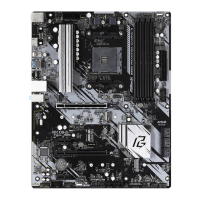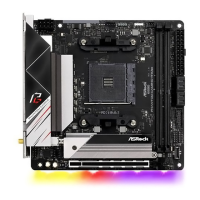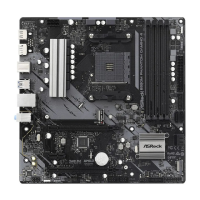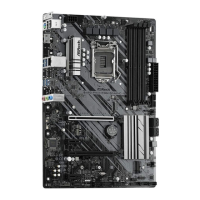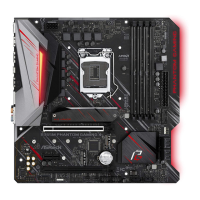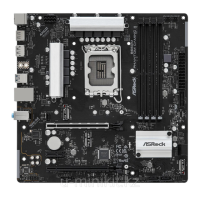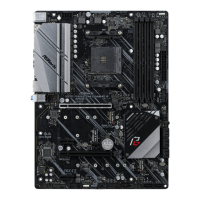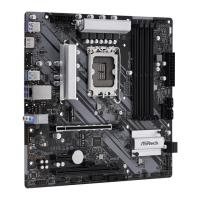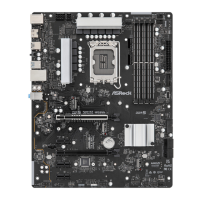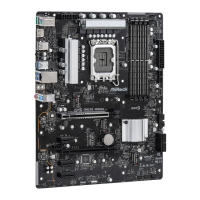Do you have a question about the ASROCK B550 PHANTOM GAMING 4 and is the answer not in the manual?
Lists all included motherboard package items.
Details the technical specifications of the motherboard components and features.
Illustrates the physical arrangement of components and connectors on the motherboard.
Describes the rear input/output ports and their functions.
Essential safety and handling guidelines before installing hardware components.
Step-by-step guide for installing the central processing unit onto the motherboard.
Instructions for mounting the CPU cooler and fan for effective heat dissipation.
Guide on properly installing RAM modules into the motherboard's DIMM slots.
Explains the different PCI Express slots and their configurations.
Details the function and proper configuration of motherboard jumpers.
Identifies and explains the purpose of internal motherboard headers and connectors.
Describes the Post Status Checker feature for diagnosing system boot issues.
Guide to setting up multi-GPU configurations using AMD CrossFireX technology.
Instructions for installing an M.2 SSD module into the M2_1 slot.
Guide for installing a WiFi/BT module into the M.2 (Key E) slot.
Instructions for installing an M.2 SSD module into the M2_3 slot.
How to install drivers and utilities from the support CD for optimal motherboard functionality.
Guide to using the ASRock utility for system tuning, monitoring, and fan control.
Information on the ASRock store for downloading apps, drivers, and BIOS updates.
Explanation of Nahimic audio software features for enhanced sound and voice performance.
Instructions for customizing RGB lighting effects using ASRock Polychrome SYNC utility.
Overview of the UEFI BIOS utility for system configuration and settings.
Description of the main menu options available in the UEFI setup interface.
Explains how to navigate through UEFI setup using keyboard keys and mouse controls.
Displays the system overview and essential hardware information upon entering UEFI.
Details settings for overclocking the CPU, memory, and other system components.
Provides access to advanced system configurations and detailed settings.
Settings related to CPU features, modes, and performance tuning options.
Options to enable or disable integrated motherboard devices like audio, LAN, etc.
Settings for SATA ports, AHCI, RAID modes, and hot-plug functionality.
Power management settings, sleep states, and wake-up events configuration.
Settings for security features, including Trusted Platform Module (TPM) support.
Access to AMD-specific Common Options and system configuration features.
Access to AMD-specific Platform Security and other relevant features.
Warning and access to advanced AMD CPU overclocking options and settings.
Utility tools for RAID installation, secure SSD erase, and UEFI firmware updates.
Displays system hardware status, including temperatures, fan speeds, and voltages.
Options for setting supervisor/user passwords and configuring Secure Boot.
Configuration of boot device priority and related boot settings.
Options for saving, discarding changes, and loading default BIOS settings.
Lists all included motherboard package items.
Details the technical specifications of the motherboard components and features.
Illustrates the physical arrangement of components and connectors on the motherboard.
Describes the rear input/output ports and their functions.
Essential safety and handling guidelines before installing hardware components.
Step-by-step guide for installing the central processing unit onto the motherboard.
Instructions for mounting the CPU cooler and fan for effective heat dissipation.
Guide on properly installing RAM modules into the motherboard's DIMM slots.
Explains the different PCI Express slots and their configurations.
Details the function and proper configuration of motherboard jumpers.
Identifies and explains the purpose of internal motherboard headers and connectors.
Describes the Post Status Checker feature for diagnosing system boot issues.
Guide to setting up multi-GPU configurations using AMD CrossFireX technology.
Instructions for installing an M.2 SSD module into the M2_1 slot.
Guide for installing a WiFi/BT module into the M.2 (Key E) slot.
Instructions for installing an M.2 SSD module into the M2_3 slot.
How to install drivers and utilities from the support CD for optimal motherboard functionality.
Guide to using the ASRock utility for system tuning, monitoring, and fan control.
Information on the ASRock store for downloading apps, drivers, and BIOS updates.
Explanation of Nahimic audio software features for enhanced sound and voice performance.
Instructions for customizing RGB lighting effects using ASRock Polychrome SYNC utility.
Overview of the UEFI BIOS utility for system configuration and settings.
Description of the main menu options available in the UEFI setup interface.
Explains how to navigate through UEFI setup using keyboard keys and mouse controls.
Displays the system overview and essential hardware information upon entering UEFI.
Details settings for overclocking the CPU, memory, and other system components.
Provides access to advanced system configurations and detailed settings.
Settings related to CPU features, modes, and performance tuning options.
Options to enable or disable integrated motherboard devices like audio, LAN, etc.
Settings for SATA ports, AHCI, RAID modes, and hot-plug functionality.
Power management settings, sleep states, and wake-up events configuration.
Settings for security features, including Trusted Platform Module (TPM) support.
Access to AMD-specific Common Options and system configuration features.
Access to AMD-specific Platform Security and other relevant features.
Warning and access to advanced AMD CPU overclocking options and settings.
Utility tools for RAID installation, secure SSD erase, and UEFI firmware updates.
Displays system hardware status, including temperatures, fan speeds, and voltages.
Options for setting supervisor/user passwords and configuring Secure Boot.
Configuration of boot device priority and related boot settings.
Options for saving, discarding changes, and loading default BIOS settings.
| Processor socket | Socket AM4 |
|---|---|
| Processor manufacturer | AMD |
| Compatible processor series | AMD Ryzen 3 3rd Gen, AMD Ryzen 5 3rd Gen, AMD Ryzen 7 3rd Gen, AMD Ryzen 9 3rd Gen |
| Maximum number of SMP processors | 1 |
| ECC | Yes |
| Memory channels | Dual-channel |
| Memory slots type | DIMM |
| Number of memory slots | 4 |
| Supported memory types | DDR4-SDRAM |
| Maximum internal memory | 128 GB |
| Supported memory clock speeds | 2133, 2400, 2667, 2933, 3200, 3466, 3600, 3733, 3800, 3866, 4000, 4133, 4200, 4266, 4333, 4400, 4466, 4533 MHz |
| RAID levels | 0, 1, 10 |
| Supported storage drive interfaces | M.2, SATA III |
| Parallel processing technology support | - |
| USB 2.0 connectors | 2 |
| USB 3.2 Gen 2 (3.1 Gen 2) connectors | 0 |
| USB 2.0 ports quantity | USB 2.0 ports have a data transmission speed of 480 Mbps, and are backwards compatible with USB 1.1 ports. You can connect all kinds of peripheral devices to them. |
| USB 3.2 Gen 1 (3.1 Gen 1) Type-A ports quantity | 6 |
| Wi-Fi | No |
| LAN controller | Realtek RTL8111H |
| Ethernet interface type | Gigabit Ethernet |
| Component for | PC |
| Motherboard chipset | AMD B550 |
| Audio output channels | 7.1 channels |
| Motherboard form factor | ATX |
| BIOS type | UEFI |
| Harmonized System (HS) code | 84733020 |
| Weight | 465 g |
| Depth | 244 mm |
|---|---|
| Width | 305 mm |
| Height | 70 mm |
